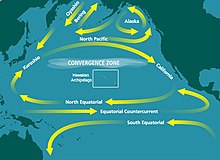Great Pacific Garbage Patch
The Great Pacific Garbage Patch is a big patch of garbage and debris in the middle of the northern Pacific Ocean. It is caught in the water currents. It formed because currents near the center of the Northern Pacific Ocean move around in an ocean gyre, which catches and holds floating pieces of plastic.

The "garbage patch" actually has two areas, described as an eastern patch and a western patch, which are separated because of ocean currents. Scientists estimate the "plastic island" is approximately as big as Texas in the United States, but it could be as much as twice the size. Also, it is not really a floating island. It is more like a soup of plastic pieces floating in the ocean just below the surface. It is 900 km (560 mi) from California, between Hawaii and Japan.[1]
Hazards
changeShips try to avoid this patch of garbage because it can get caught in their screws.[2]
Many birds, turtles, and other sea animals go to Pacific Islands to lay their eggs and raise their young. Unfortunately, they eat the smaller pieces of plastic, thinking that they are food swimming in the ocean. They also get caught in the garbage. The United Nations Environment Program estimates that the plastic soup causes the death of one million sea birds and 10,000 sea animals every year. Some micro-invertebrates have also been found to eat tiny pieces of plastic with similar results.[3]
Composition
changeFor a long time, people thought the garbage patch was mostly plastic that had been used by ordinary people, like plastic straws and forks. In 2018, scientists found out that most of the plastic in the patch was lost fishing nets and other fishing tools used on large fishing boats.[4][5]
Since the plastics are organic compounds, they tend to absorb other organic compounds, such as pesticides. Scientists have discovered high levels of DDT and other organic compounds in this deadly plastic soup.
Sources
changeThe pieces of plastic come from all over the world. Any country that has a shore or river where pieces of plastic blow or wash out to sea is a source. Scientists estimate that the United States and other industrial countries contribute less garbage to the plastic island due to modern garbage disposal. However, these countries also produce and sell much of the plastic that becomes garbage for non-industrial countries.
Changes
changeChanging winds and currents often cause parts of this plastic island to break away and send pieces of plastic toward the beaches and shorelines of Pacific Islands and the continents. It is considered a major problem for tourism as well as island and ocean environments.
This is a worldwide environmental problem.
Cleanup
changeIn April 2008, Richard Sundance Owen, a building contractor and scuba dive instructor, started the Environmental Cleanup Coalition to solve the problem of the pollution in the North Pacific. They are working with other groups to find ways to safely remove plastic and organic compounds from the oceans.[6]
Project Kaisei is a project that launched in March 2009 to study and clean up the garbage patch. In August 2009, two ships from the project, the RV New Horizon and the Kaisei, went to research the patch and decide the possibility of a commercial scale collection and recycling operation.[7][8]
References
change- ↑ San Francisco Chronicle Article http://www.sfgate.com/cgi-bin/article.cgi?f=/c/a/2007/10/19/SS6JS8RH0.DTL&hw=pacific+patch&sn=001&sc=1000
- ↑ The United Kingdom Independent article https://www.independent.co.uk/environment/the-worlds-rubbish-dump-a-garbage-tip-that-stretches-from-hawaii-to-japan-778016.html
- ↑ Natural History Magazine http://www.naturalhistorymag.com/master.html?http://www.naturalhistorymag.com/1103/1103_feature.html
- ↑ Laura Parker (March 22, 2018). "The Great Pacific Garbage Patch Isn't What You Think it Is". National Geographic. Retrieved December 9, 2019.
- ↑ L. Lebreton, B. Slat, F. Ferrari, B. Sainte-Rose, J. Aitken, R. Marthouse, S. Hajbane, S. Cunsolo, A. Schwarz, A. Levivier, K. Noble, P. Debeljak, H. Maral, R. Schoeneich-Argent, R. Brambini, and J. Reisser (March 22, 2018). "Evidence that the Great Pacific Garbage Patch is rapidly accumulating plastic". Scientific Reports. Retrieved December 9, 2019.
{{cite web}}: CS1 maint: multiple names: authors list (link) - ↑ "gyrecleanup.org". www.gyrecleanup.org.
- ↑ Walsh, Bryan (1 August 2009). "Expedition Sets Sail to the Great Plastic Vortex". Time. Archived from the original on 4 August 2009. Retrieved 2 August 2009.
- ↑ "Scientists study huge plastic patch in Pacific - Yahoo! News". Archived from the original on 2009-08-16. Retrieved 2017-08-31.